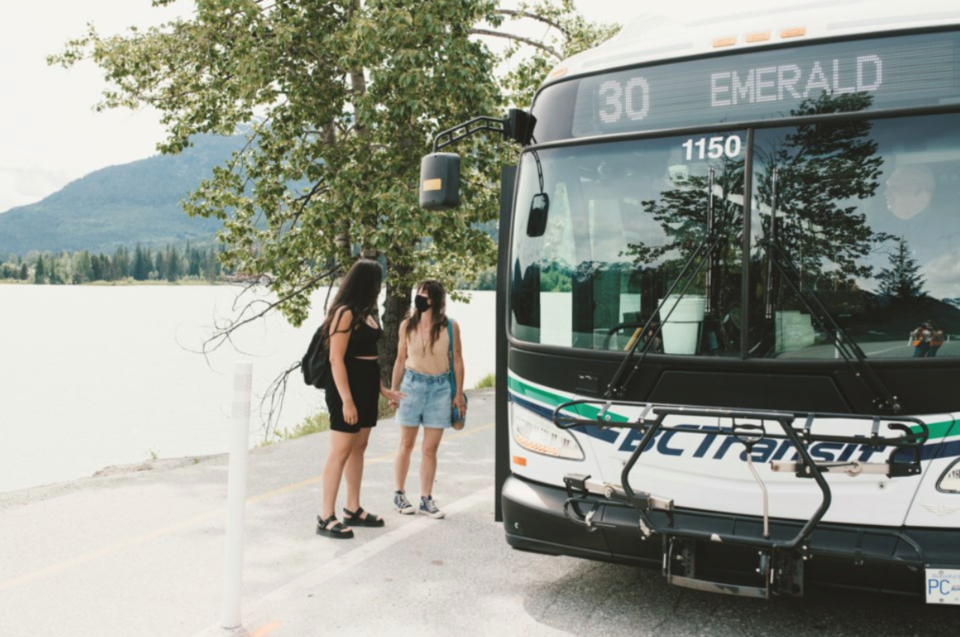Following a four-month transit strike earlier this year, Whistler’s mayor and council is looking to revitalize transit in the resort by way of an update to the Transit Future Action Plan (TFAP).
Council approved the update, which lays out the goals and objectives for the expansion of Whistler’s transit system over the next five years, at its Sept. 6 meeting.
The TFAP is a long-term, 25-year plan updated every five years to adjust for new priorities and population change and create efficiency in the transit system. Over the next five years, Whistler’s TFAP is targeting an additional 25,800 transit service hours (TSH), which amounts to a 35-per-cent increase in Whistler’s current TSH (from 74,800 to 100,600).
Additionally, the plan calls for increased capital investments, including nine new buses, a rapid transit network study (to optimize the Route 10 Valley Express), and improvements to amenities at transit stops.
Potential expansion to the transit service over the next five years includes increasing frequency throughout the municipality, especially the Route 10 Valley Express, and eventually adding new routes like an Alta Lake connector. The municipality will continue working toward its goals of electrification of the fleet, implementing an electronic fare collection system, bringing back late winter service in April 2023, and beginning service earlier in December 2023.
The Resort Municipality of Whistler (RMOW) also reiterated its request for the province to approve 5,000 more TSH. It previously submitted a request for those additional hours that was declined because the 2022 provincial budget did not include any additional funding for transit.
The TFAP was designed using feedback gleaned from the public through various stakeholder meetings, workshops and online surveys. According to the feedback received, the public’s top priorities for the transit system are increased service to Whistler’s southern neighbourhoods, improvements to bus stops along Highway 99 and creating a new bus route connecting Alta Lake Road residents to the transit system.
Whistler Mayor Jack Crompton welcomed the updated plan. “Increasing transit service hours allows us to focus on initiatives that improve the frequency and convenience of our transit service, both of which are strong drivers when it comes to getting people to take the bus,” he said in a release.
“By investing in improvements to transit services and infrastructure, we’re taking important steps in moving beyond the car and meeting our climate action targets.”
The report noted the number of people using the transit system as their primary form of transportation in 2019 was close to the numbers seen in 2015 (14.5 per cent and 15 per cent, respectively). The RMOW has some work to do on that front if it wants to meet its goal of having 20 per cent of all trips taken by transit by 2025, and 40 per cent by 2040. In 2021, during the pandemic, only seven per cent of Whistlerites used transit as their main mode of transportation.
The Route 10 Valley Express has proven to be very popular with Whistlerites, the report noted, as the line’s ridership grew by 175 per cent between 2019 and 2021, making it the fifth busiest route overall, and the only route to increase in ridership during the pandemic. Route 20, which connects Cheakamus Crossing to the village, remains the most popular route in the system, followed by routes 30 and 5.
The Whistler Transit System remains sizable for a municipality the size of Whistler, with 31 vehicles in operation on 13 routes, carrying 3.2 million passengers in 2019—a 26-per-cent increase over the past five years.
The updated TFAP proposes that three quarters of the expansion happen in the first three years of the plan at an estimated additional net cost to the RMOW of about $1.5 million. The first year of the expansion plan is estimated to cost the municipality $298,637. However, the staff report noted that BC Transit will have to request matching funds from the provincial government, and will only receive confirmation in February when the provincial budget is released.
The additional costs could be accommodated by a combination of property tax increases, parking fees and Resort Municipality Initiative (RMI) funds, the report to council suggested.





